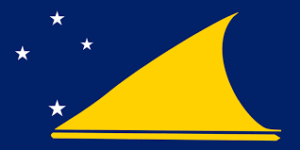Tokelau is an island nation in the Pacific Ocean and a territory of New Zealand. The islands were originally settled by Polynesians who migrated from the surrounding islands. In 1889 these islands came under British control, then transferred to New Zealand in 1925.
Tokelau is a very small area with a current population of less than 1500 people.
| Capital | none; each atoll has its own administrative center |
| Population | 1,897 (Source: 2023 worldometer) |
| Major Cities | Atafu, Nukunonu, Fale old settlement, |
| Borders | north of the Samoan Islands, east of Tuvalu, south of the Phoenix Islands, southwest of the more distant Line Islands, and northwest of the Cook Islands |
| Gross Domestic Product (GDP) | $7,711,583 (2022 worldfactbook) |
| Currency | New Zealand dollar (NZD) |

Tokelau Major Industries: small-scale enterprises for copra production, woodworking, plaited craft goods; stamps, coins; fishing
Tokelau Agricultural Products: coconuts, copra, breadfruit, papayas, bananas; pigs, poultry, goats; fish
Tokelau Natural Resources: NEGL
Tokelau Major Exports: stamps, copra, handicrafts
Tokelau Major Imports: foodstuffs, building materials, fuel
Total Size of Tokelau: 10.8 km2 (source: 2022 wikipedia)
Geographical Low Point of Tokelau: Pacific Ocean 0 m
Geographical High Point of Tokelau: unnamed location 5 m
Climate of Tokelau: Tropical; moderated by trade winds (April to November)
General Terrain of Tokelau: low-lying coral atolls enclosing large lagoons
World Region or Continent of Tokelau: Oceania
Geographical Coordinates: 9 00 S, 172 00 W
Tokelau Government Type: NA
Tokelau Nationality: Tokelauan(s)
Tokelau National Holiday: Waitangi Day (Treaty of Waitangi established British sovereignty over New Zealand), 6 February (1840)
Tokelau Independence: none (territory of New Zealand)
Tokelau National Symbol: tuluma (fishing tackle box)
Tokelau National Anthem or Song: Te Atua (For the Almighty)
Tokelau Languages Spoken: Tokelauan (a Polynesian language), English
Tokelau Religions: Congregational Christian Church 70%, Roman Catholic 28%, other 2%
It is one of the smallest countries in the world with a total population of just about 1500 people. Pretty impressive!
Nothing is produced in Tokelau and everything available on the island comes from New Zealand. The only thing the locals can do for themselves is fishing. sometimes.
In fact, Tokelau was governed by the New Zealand government and local residents had New Zealand passports. The whole country exists at the expense of New Zealand’s support.
There are no flights to Tokelau, so it can only be accessed by cargo ship. There is no choice but to board a ship that comes several times a month from Samoa. A one-way trip takes about three days.
It is not possible to visit Tokelau without prior permission. If you want to stay on the island for at least one night, in addition to paperwork, you will have to negotiate with the local elders.
All the electricity available here is generated by solar panels. It is the only country in the world where 100% of the electricity consumed comes from the sun. And that’s really great for ecology!
The sale of commemorative coins, stamps and national domains in the .tk zone constitutes a significant portion of Tokelau’s budget.
The name of the country is translated from the local language as “northern wind”.
The official head of Tokelau is the Queen of England.

